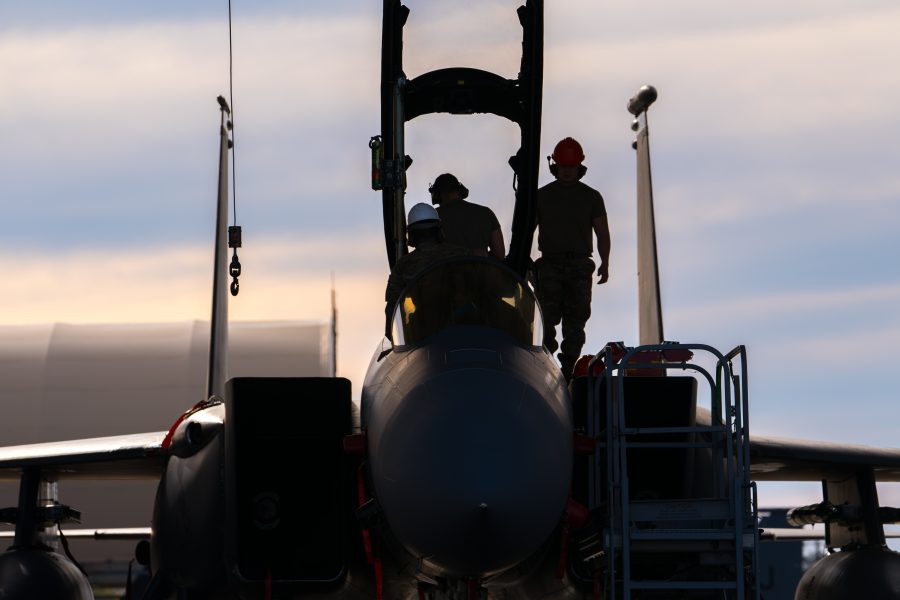The Air Force plans to cut its F-15E fleet to 99 aircraft in the coming years—cutting more than 100 Strike Eagles from the fleet. The move comes as the service seeks to modernize and bring on new platforms while still keeping enough fighters to be able to meet mission demands.
When asked about the move by Sen. Ted Budd (R-N.C.) on July 11, Air Force Chief of Staff Gen. Charles Q. Brown, Jr. said the determination was made to “balance capability and capacity.” Brown’s comments came during his confirmation hearing before the Senate Armed Services Committee to become Chairman of the Joint Chiefs of Staff, which featured extensive questioning on Air Force weapons and aircraft program decisions.
In budget documents released by the Department of Defense on future force structure in May, the Air Force said it wants to keep 99 F-15Es and spend money to upgrade all those jets with the Eagle Passive Active Warning Survivability System (EPAWSS), an electronic warfare suite which has already been installed on some aircraft. The service currently has 218 F-15Es with an average age of more than 30 years.
F-15Es have one of two engines: the newer model fighters are equipped with Pratt & Whitney’s F100-PW-229, an upgraded version of the F100-PW-220 engines on older F-15E models. The Air Force has decided to keep the models with better engines and modernize them in other ways.
Budd, whose state includes one of the USAF’s five F-15E bases, Seymour Johnson Air Force Base—as well as some other lawmakers and military experts—expressed concern about the Air Force’s fighter capacity.
Brown and other Air Force officials have acknowledged the service had to make tough calls due to budget constraints.
“Prioritizing modernization efforts to keep pace with near-peer competitors requires difficult tradeoffs with existing aircraft inventories and programs,” according to the Air Force’s justification for its future force structure changes. ”The Air Force determined the best mix for the fighter fleet calls for maintaining an F-15E fleet of 99 aircraft with the more powerful engine (F-100-PW-229) and shifting resources to maximize procurement of newer fighters and capabilities.”
EPAWSS was already planned for installation on the USAF’s F-15E fleet as part of a modernization of its aging “analog, federated system with a next-generation, digital, fully-integrated EW suite that enables the F-15 to operate in a modern threat environment,” according to the Air Force Life Cycle Management Center. Now, that fleet will shrink to 99 by 2028.
But Congress ultimately determines what the service is allowed to do. Lawmakers often block the Pentagon from retiring or canceling some programs year-to-year and have previously inserted language into bills that prohibit retiring certain aircraft. No current language exists that prevents the Air Force from retiring F-15Es in the future and the service does not plan to retire any Strike Eagles in the 2023 or 2024 fiscal years.
Along with F-15Es, the Air Force plans to buy 104 F-15EX Eagle IIs, the newest variant of the venerable multirole fourth-generation fighter. The F-15EX is also equipped with EPAWSS. In fiscal 2024, the Air Force wants to buy 72 new fighters: 24 F-15EXs and 48 F-35 Lightning IIs.
Meanwhile, the service is rapidly divesting its aging F-15C/D air-to-air fighters, which first entered service in the late 1970s—in 2024, the service wants to cut 57. The F-15E entered service roughly 10 years after the C/D models.
“As we do this, it’s not just the platforms themselves, it’s the other aspects of our command and control in terms of bringing some reconnaissance capabilities that we will continue to invest,” Brown said of the service’s modernization decisions. Brown said the Air Force aims to “make those fighters more relevant and combat capable as we go forward.”
